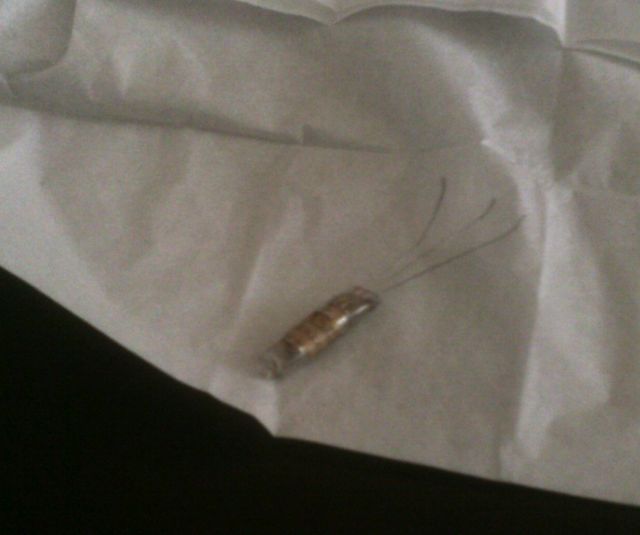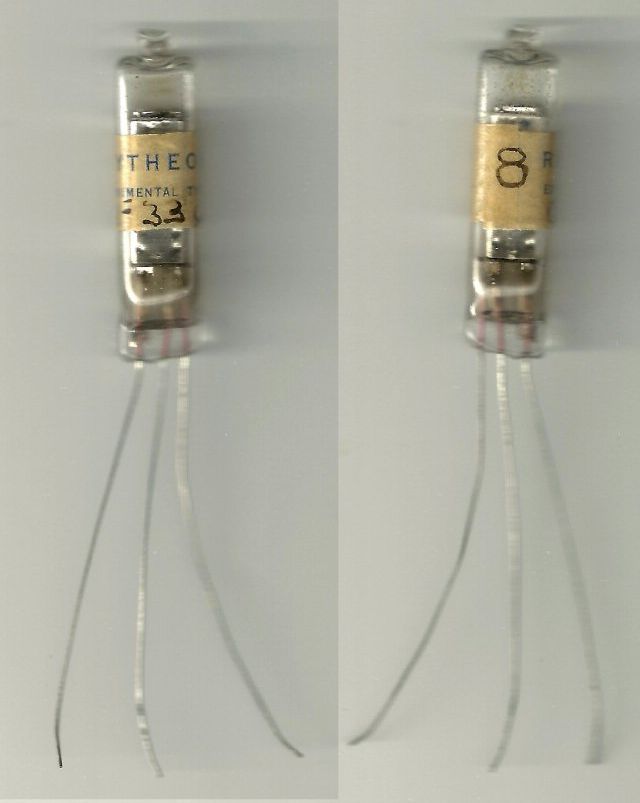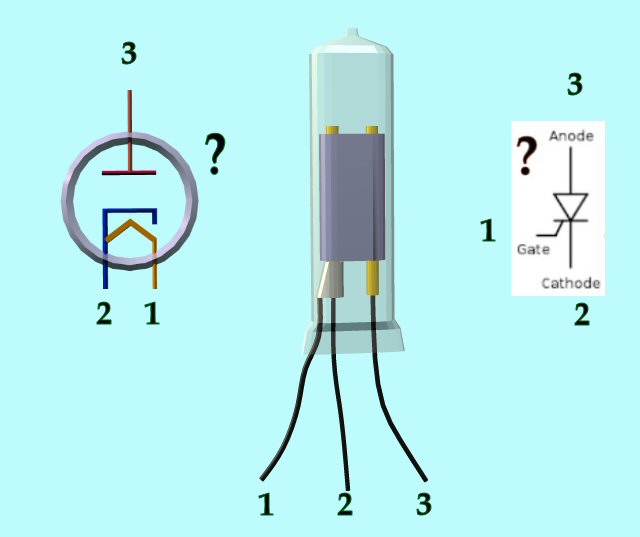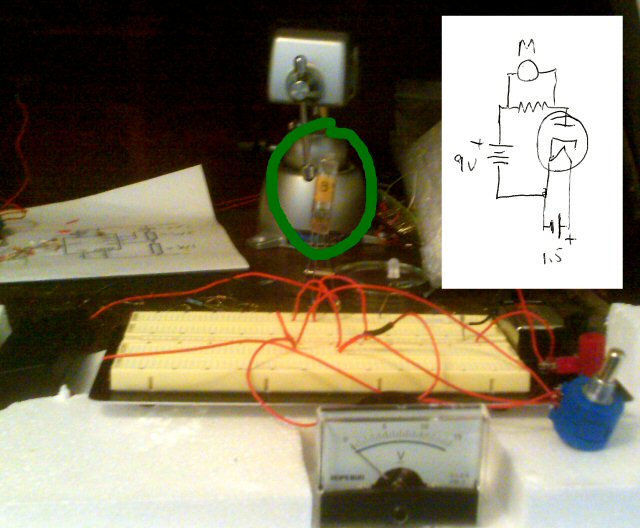Saturday, May 28, 2016
Experimental non-transistor
I was idly browsing Ebay for Soviet transistors. Curious to see if the oldest ones looked similar to America's oldest transistors. Mostly yes. The Prince Albert shape of the early ones reminded me of my first live encounter with a transistor.....
Around 1958 I was fiddling with radios and electric stuff, and somehow picked up a catalog from Burstein Applebee. Spent hours dreaming through it. When parents visited an uncle in KC, I badgered them into letting me see the Burstein Applebee store in downtown KCMO. They dropped me off and went shopping somewhere else. I walked in and started wandering the aisles, marveling at all the receivers and antennas and tubes. The clerks were NOT happy to have an 8-year-old loose in the store. They herded me out, but not before I got a good look at THE REAL THING: A Raytheon CK722.
Does Ebay have CK722s? Plenty of them but that wasn't the most interesting item. Seller VintChip had a Raytheon 'experimental transistor' for $50.
Instant choice. Had to buy it.
Unpacking......
 Vintchip does a good job of packing. Bubble wrap and tissue.
Vintchip does a good job of packing. Bubble wrap and tissue.
 First impression: Printed label says Raytheon Experimental. Written in ink on one side is QF336, on the other side just the number 8. Presumption: This is serial number 8 of a set of experimental tubes denominated QF336.
Scanned both sides:
First impression: Printed label says Raytheon Experimental. Written in ink on one side is QF336, on the other side just the number 8. Presumption: This is serial number 8 of a set of experimental tubes denominated QF336.
Scanned both sides:
 Looks very much like a miniature hearing-aid tube. Same glass outer envelope, same leads coming through the bottom sealed in glass, same 'can' surrounding the active part. Mini tubes were used in hearing aids briefly in the '50s. Hearing aids soon switched to transistors, but not because of size. Early transistors were about half the size of mini tubes and you needed two or three transistors to substitute for the typical tube. No real advantage. Batteries were the advantage. Tubes needed a large 1.5V filament batt and a large 45V plate batt, and used up the filament batt fast. Transistors used one 9V battery and drained it slowly.
= = = = =
Looks very much like a miniature hearing-aid tube. Same glass outer envelope, same leads coming through the bottom sealed in glass, same 'can' surrounding the active part. Mini tubes were used in hearing aids briefly in the '50s. Hearing aids soon switched to transistors, but not because of size. Early transistors were about half the size of mini tubes and you needed two or three transistors to substitute for the typical tube. No real advantage. Batteries were the advantage. Tubes needed a large 1.5V filament batt and a large 45V plate batt, and used up the filament batt fast. Transistors used one 9V battery and drained it slowly.
= = = = =
 I can see the innards with a magnifier, but couldn't get a photo or scan. So I made a Poser version to illustrate. Two cylinders running through the can in parallel; one cylinder has one wire from it, and the other cylinder has a sort of sheath, with one wire centered and another wire Y-ing out of the sheath.
Innards STRONGLY suggest tube. The sheathed electrode is typical of a cathode with inner heater, with one side of heater tied to cathode. The opposite cylinder looks like the plate. Thinking tubey, this webpage shows a Sylvania experimental miniature thyratron, looking something like qf336, but the Sylvania has four terminals, which seems right. This critter has only three wires, which means it can't be a triode or a thyratron. Could it be a rectifier or a voltage-dependent switch?
One problem with tube assumption: the upper and lower ends of the can are closed by resin or epoxy. Tubes generally get too hot for epoxy.
Thinking solid-statey, the wire pattern reminds me of a thyristor or SCR schematic. Does this mean the schematic was meant to imitate this device? Probably not.
Well, let's try both assumptions. Using DVM, no connectedness shows between the terminals. On R scale and diode scale, just open ckt in both directions on all combinations of the three wires. About 7nF capacitance between terminals, which makes sense from the structure but doesn't mean anything. So this probably isn't solid-state, because even a blown or non-functional solid thing will show some kind of resistance.
I don't have any proper mini tubes for comparison. A large tube (35L6) shows about 40Ω across the filament, varying as the applied voltage slightly warms the heater. I don't know what to expect for a mini tube, but it would certainly be low enough to read easily. Two-digit ohms, not gonna look like open ckt.
= = = = =
Just for fun, trying the tube assumption in the simplest possible ckt for a rectifier. Battery across the filament, cathode to negative, 9V to the plate through a resistor, with voltmeter across the resistor to see if anything flows.
I can see the innards with a magnifier, but couldn't get a photo or scan. So I made a Poser version to illustrate. Two cylinders running through the can in parallel; one cylinder has one wire from it, and the other cylinder has a sort of sheath, with one wire centered and another wire Y-ing out of the sheath.
Innards STRONGLY suggest tube. The sheathed electrode is typical of a cathode with inner heater, with one side of heater tied to cathode. The opposite cylinder looks like the plate. Thinking tubey, this webpage shows a Sylvania experimental miniature thyratron, looking something like qf336, but the Sylvania has four terminals, which seems right. This critter has only three wires, which means it can't be a triode or a thyratron. Could it be a rectifier or a voltage-dependent switch?
One problem with tube assumption: the upper and lower ends of the can are closed by resin or epoxy. Tubes generally get too hot for epoxy.
Thinking solid-statey, the wire pattern reminds me of a thyristor or SCR schematic. Does this mean the schematic was meant to imitate this device? Probably not.
Well, let's try both assumptions. Using DVM, no connectedness shows between the terminals. On R scale and diode scale, just open ckt in both directions on all combinations of the three wires. About 7nF capacitance between terminals, which makes sense from the structure but doesn't mean anything. So this probably isn't solid-state, because even a blown or non-functional solid thing will show some kind of resistance.
I don't have any proper mini tubes for comparison. A large tube (35L6) shows about 40Ω across the filament, varying as the applied voltage slightly warms the heater. I don't know what to expect for a mini tube, but it would certainly be low enough to read easily. Two-digit ohms, not gonna look like open ckt.
= = = = =
Just for fun, trying the tube assumption in the simplest possible ckt for a rectifier. Battery across the filament, cathode to negative, 9V to the plate through a resistor, with voltmeter across the resistor to see if anything flows.
 Nope. No heat from the filament, no flow at all.
Conclusion: This is probably a diode tube, and the filament is probably burned out.
= = = = =
Well. Was this $50 worth of fun? Yes! I got to handle a little piece of history, got to solve a little mystery. Whatever this thing is, it's NOT solid state. Most likely a rectifier tube, perhaps with gas that glows or provides a sudden discharge for a 'fuse'.
More importantly, this gives me an idea for some old-fashioned messing around. I never experimented with normal-size tubes because they require multiple high voltages and serious sheetmetal work. Way too much danger and 'overhead' for experimenting. These mini tubes can be run on batteries and can be popped into a regular breadboard. Many of them take 22.5V plate, which I can grab conveniently and safely from the rechargeable batt for my weed-whacker.
= = = = =
Next fun here.
Nope. No heat from the filament, no flow at all.
Conclusion: This is probably a diode tube, and the filament is probably burned out.
= = = = =
Well. Was this $50 worth of fun? Yes! I got to handle a little piece of history, got to solve a little mystery. Whatever this thing is, it's NOT solid state. Most likely a rectifier tube, perhaps with gas that glows or provides a sudden discharge for a 'fuse'.
More importantly, this gives me an idea for some old-fashioned messing around. I never experimented with normal-size tubes because they require multiple high voltages and serious sheetmetal work. Way too much danger and 'overhead' for experimenting. These mini tubes can be run on batteries and can be popped into a regular breadboard. Many of them take 22.5V plate, which I can grab conveniently and safely from the rechargeable batt for my weed-whacker.
= = = = =
Next fun here.
 Vintchip does a good job of packing. Bubble wrap and tissue.
Vintchip does a good job of packing. Bubble wrap and tissue.
 First impression: Printed label says Raytheon Experimental. Written in ink on one side is QF336, on the other side just the number 8. Presumption: This is serial number 8 of a set of experimental tubes denominated QF336.
Scanned both sides:
First impression: Printed label says Raytheon Experimental. Written in ink on one side is QF336, on the other side just the number 8. Presumption: This is serial number 8 of a set of experimental tubes denominated QF336.
Scanned both sides:
 Looks very much like a miniature hearing-aid tube. Same glass outer envelope, same leads coming through the bottom sealed in glass, same 'can' surrounding the active part. Mini tubes were used in hearing aids briefly in the '50s. Hearing aids soon switched to transistors, but not because of size. Early transistors were about half the size of mini tubes and you needed two or three transistors to substitute for the typical tube. No real advantage. Batteries were the advantage. Tubes needed a large 1.5V filament batt and a large 45V plate batt, and used up the filament batt fast. Transistors used one 9V battery and drained it slowly.
= = = = =
Looks very much like a miniature hearing-aid tube. Same glass outer envelope, same leads coming through the bottom sealed in glass, same 'can' surrounding the active part. Mini tubes were used in hearing aids briefly in the '50s. Hearing aids soon switched to transistors, but not because of size. Early transistors were about half the size of mini tubes and you needed two or three transistors to substitute for the typical tube. No real advantage. Batteries were the advantage. Tubes needed a large 1.5V filament batt and a large 45V plate batt, and used up the filament batt fast. Transistors used one 9V battery and drained it slowly.
= = = = =
 I can see the innards with a magnifier, but couldn't get a photo or scan. So I made a Poser version to illustrate. Two cylinders running through the can in parallel; one cylinder has one wire from it, and the other cylinder has a sort of sheath, with one wire centered and another wire Y-ing out of the sheath.
Innards STRONGLY suggest tube. The sheathed electrode is typical of a cathode with inner heater, with one side of heater tied to cathode. The opposite cylinder looks like the plate. Thinking tubey, this webpage shows a Sylvania experimental miniature thyratron, looking something like qf336, but the Sylvania has four terminals, which seems right. This critter has only three wires, which means it can't be a triode or a thyratron. Could it be a rectifier or a voltage-dependent switch?
One problem with tube assumption: the upper and lower ends of the can are closed by resin or epoxy. Tubes generally get too hot for epoxy.
Thinking solid-statey, the wire pattern reminds me of a thyristor or SCR schematic. Does this mean the schematic was meant to imitate this device? Probably not.
Well, let's try both assumptions. Using DVM, no connectedness shows between the terminals. On R scale and diode scale, just open ckt in both directions on all combinations of the three wires. About 7nF capacitance between terminals, which makes sense from the structure but doesn't mean anything. So this probably isn't solid-state, because even a blown or non-functional solid thing will show some kind of resistance.
I don't have any proper mini tubes for comparison. A large tube (35L6) shows about 40Ω across the filament, varying as the applied voltage slightly warms the heater. I don't know what to expect for a mini tube, but it would certainly be low enough to read easily. Two-digit ohms, not gonna look like open ckt.
= = = = =
Just for fun, trying the tube assumption in the simplest possible ckt for a rectifier. Battery across the filament, cathode to negative, 9V to the plate through a resistor, with voltmeter across the resistor to see if anything flows.
I can see the innards with a magnifier, but couldn't get a photo or scan. So I made a Poser version to illustrate. Two cylinders running through the can in parallel; one cylinder has one wire from it, and the other cylinder has a sort of sheath, with one wire centered and another wire Y-ing out of the sheath.
Innards STRONGLY suggest tube. The sheathed electrode is typical of a cathode with inner heater, with one side of heater tied to cathode. The opposite cylinder looks like the plate. Thinking tubey, this webpage shows a Sylvania experimental miniature thyratron, looking something like qf336, but the Sylvania has four terminals, which seems right. This critter has only three wires, which means it can't be a triode or a thyratron. Could it be a rectifier or a voltage-dependent switch?
One problem with tube assumption: the upper and lower ends of the can are closed by resin or epoxy. Tubes generally get too hot for epoxy.
Thinking solid-statey, the wire pattern reminds me of a thyristor or SCR schematic. Does this mean the schematic was meant to imitate this device? Probably not.
Well, let's try both assumptions. Using DVM, no connectedness shows between the terminals. On R scale and diode scale, just open ckt in both directions on all combinations of the three wires. About 7nF capacitance between terminals, which makes sense from the structure but doesn't mean anything. So this probably isn't solid-state, because even a blown or non-functional solid thing will show some kind of resistance.
I don't have any proper mini tubes for comparison. A large tube (35L6) shows about 40Ω across the filament, varying as the applied voltage slightly warms the heater. I don't know what to expect for a mini tube, but it would certainly be low enough to read easily. Two-digit ohms, not gonna look like open ckt.
= = = = =
Just for fun, trying the tube assumption in the simplest possible ckt for a rectifier. Battery across the filament, cathode to negative, 9V to the plate through a resistor, with voltmeter across the resistor to see if anything flows.
 Nope. No heat from the filament, no flow at all.
Conclusion: This is probably a diode tube, and the filament is probably burned out.
= = = = =
Well. Was this $50 worth of fun? Yes! I got to handle a little piece of history, got to solve a little mystery. Whatever this thing is, it's NOT solid state. Most likely a rectifier tube, perhaps with gas that glows or provides a sudden discharge for a 'fuse'.
More importantly, this gives me an idea for some old-fashioned messing around. I never experimented with normal-size tubes because they require multiple high voltages and serious sheetmetal work. Way too much danger and 'overhead' for experimenting. These mini tubes can be run on batteries and can be popped into a regular breadboard. Many of them take 22.5V plate, which I can grab conveniently and safely from the rechargeable batt for my weed-whacker.
= = = = =
Next fun here.
Nope. No heat from the filament, no flow at all.
Conclusion: This is probably a diode tube, and the filament is probably burned out.
= = = = =
Well. Was this $50 worth of fun? Yes! I got to handle a little piece of history, got to solve a little mystery. Whatever this thing is, it's NOT solid state. Most likely a rectifier tube, perhaps with gas that glows or provides a sudden discharge for a 'fuse'.
More importantly, this gives me an idea for some old-fashioned messing around. I never experimented with normal-size tubes because they require multiple high voltages and serious sheetmetal work. Way too much danger and 'overhead' for experimenting. These mini tubes can be run on batteries and can be popped into a regular breadboard. Many of them take 22.5V plate, which I can grab conveniently and safely from the rechargeable batt for my weed-whacker.
= = = = =
Next fun here.Labels: defensible spaces, new toy, TMI
